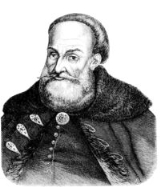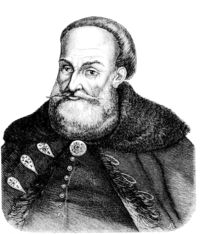
Marcin Kazanowski
Encyclopedia
Marcin Kazanowski |
|
| EWLINE |
|
| Noble Family Szlachta The szlachta was a legally privileged noble class with origins in the Kingdom of Poland. It gained considerable institutional privileges during the 1333-1370 reign of Casimir the Great. In 1413, following a series of tentative personal unions between the Grand Duchy of Lithuania and the Kingdom of... |
|
| Coat of Arms Polish heraldry Polish heraldry is a branch of heraldry focused on studying the development of coats of arms in the lands of historical Poland , as well as specifically-Polish traits of heraldry. The term is also used to refer to Polish heraldic system, as opposed to systems used elsewhere, notably in Western Europe... |
Grzymała |
| Parents | Mikołaj Kazanowski Katarzyna Korycinska |
| Consorts | Katarzyna Starzycka |
| Children | Dominik Aleksander Kazanowski Dominik Aleksander Kazanowski Dominik Aleksander Kazanowski , , was a noble , magnate, voivode of Bracław Voivodeship in the Polish-Lithuanian Commonwealth.... |
| Date of Birth | 1563/66 |
| Place of Birth | ? |
| Date of Death | October 19, 1636 |
| Place of Death | ? |
Marcin Kazanowski, (1563/1566 - 19 October 1636, the year of birth is not certain due to several conflicting sources) was a noble
Nobility
Nobility is a social class which possesses more acknowledged privileges or eminence than members of most other classes in a society, membership therein typically being hereditary. The privileges associated with nobility may constitute substantial advantages over or relative to non-nobles, or may be...
(szlachcic), magnate
Magnate
Magnate, from the Late Latin magnas, a great man, itself from Latin magnus 'great', designates a noble or other man in a high social position, by birth, wealth or other qualities...
, castellan
Castellan
A castellan was the governor or captain of a castle. The word stems from the Latin Castellanus, derived from castellum "castle". Also known as a constable.-Duties:...
of Halice from 1622, voivode of Podole Voivodeship
Podole Voivodeship
The Podole Voivodeship was a unit of administrative division and local government in the Kingdom of Poland, since the 14th century till 1793/1795, except for a short period of Ottoman Empire administration as Podolia Eyalet. Together with the Bracław Voivodeship it formed the historical province...
from 1632 and Field Crown Hetman
Hetman
Hetman was the title of the second-highest military commander in 15th- to 18th-century Poland and the Grand Duchy of Lithuania, which together, from 1569 to 1795, comprised the Polish-Lithuanian Commonwealth, or Rzeczpospolita....
of the Polish-Lithuanian Commonwealth
Polish-Lithuanian Commonwealth
The Polish–Lithuanian Commonwealth was a dualistic state of Poland and Lithuania ruled by a common monarch. It was the largest and one of the most populous countries of 16th- and 17th‑century Europe with some and a multi-ethnic population of 11 million at its peak in the early 17th century...
from 1633.
Married to Katarzyna Starzycka in 1600. Parent of Dominik Aleksander Kazanowski
Dominik Aleksander Kazanowski
Dominik Aleksander Kazanowski , , was a noble , magnate, voivode of Bracław Voivodeship in the Polish-Lithuanian Commonwealth....
(1605-1648), voivode of Bracław.

Kazanów
Kazanów may refer to the following places in Poland:*Kazanów, Lower Silesian Voivodeship *Kazanów, Masovian Voivodeship...
in 1566.
Under hetman Stanisław Koniecpolski, he was one of the commanding officers in the Battle of Górzno in 1629 against the Swedes
Sweden
Sweden , officially the Kingdom of Sweden , is a Nordic country on the Scandinavian Peninsula in Northern Europe. Sweden borders with Norway and Finland and is connected to Denmark by a bridge-tunnel across the Öresund....
.
The discovery legend of the Madonna Bołszowiecka relates that during one of battles against Tatars, hetman Kazanowski discovered the icon
Icon
An icon is a religious work of art, most commonly a painting, from Eastern Christianity and in certain Eastern Catholic churches...
of the Blessed Virgin. This was viewed by his troops as a miracle
Miracle
A miracle often denotes an event attributed to divine intervention. Alternatively, it may be an event attributed to a miracle worker, saint, or religious leader. A miracle is sometimes thought of as a perceptible interruption of the laws of nature. Others suggest that a god may work with the laws...
and boosted their morale, leading to a victory.
Under king Władysław IV Waza, he also participated in the wars against the Russian Empire
Russian Empire
The Russian Empire was a state that existed from 1721 until the Russian Revolution of 1917. It was the successor to the Tsardom of Russia and the predecessor of the Soviet Union...
.

